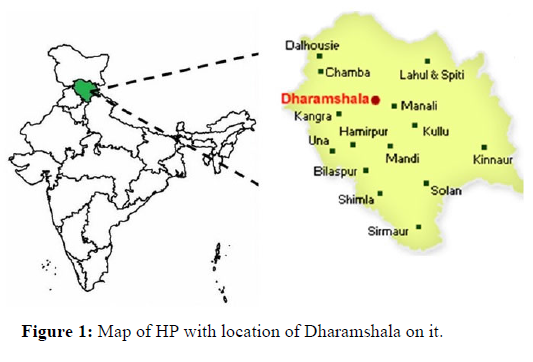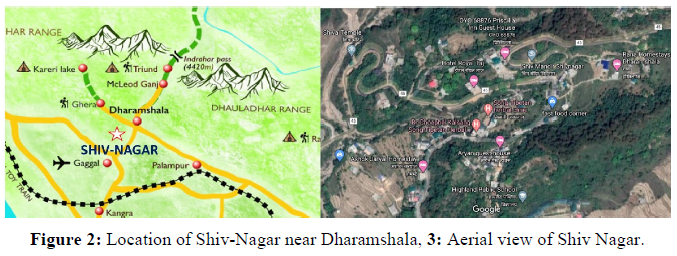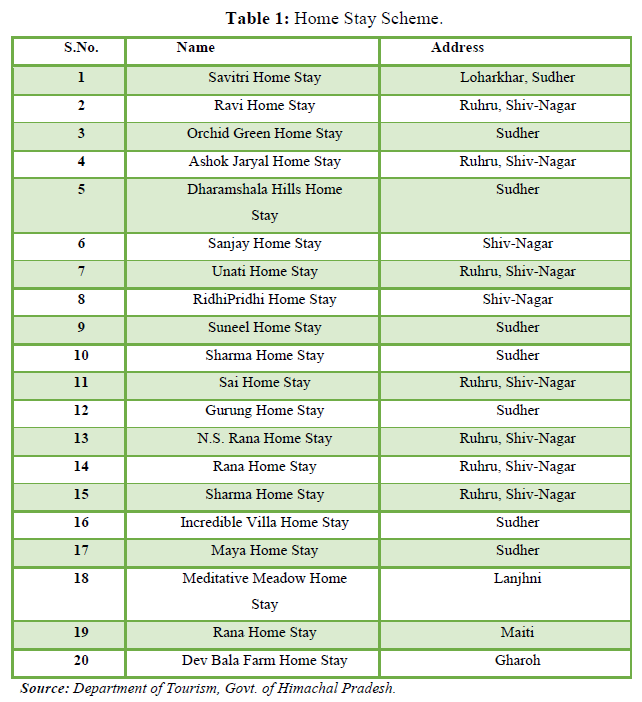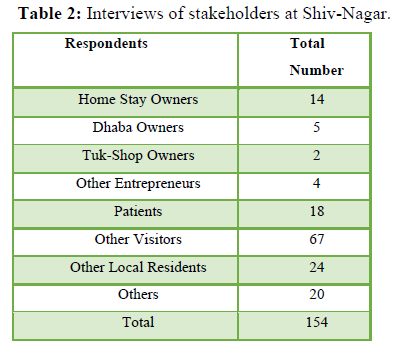Research Article
OPPORTUNITIES AND CHALLENGES OF ENTREPRENEURIAL VENTURES IN RURAL HILLS: A STUDY OF SHIV-NAGAR VILLAGE AT DHARAMSHALA
4302
Views & Citations3302
Likes & Shares
Present world has become global village and any trend which is happening in one corner of the world definitely leaves its impression in some other part of the globe. Entrepreneurship is one of such trends for which all developed as well as developing nations stand by it for its generation and promotion in their respective territories. Most of the industries, different levels of societies have been influenced by entrepreneurship due to innovation, productivity, employment and economy associated with it. There are many opportunities available for entrepreneurial ventures in cosmopolitan, metro or even small cities and towns. But as far rural areas are concerned the picture is still shabby. The opportunities keep narrowing if the rural areas of hills are considered for these ventures. In India, towns nestled in hills, most of them on the foothills of Himalayas are prone to tourism related ventures mainly. Secondly, these hills are right place for the ventures related to medicinal plants and herbs available in the lap of Himalayas. For tourism related ventures, rural areas of hills still need proper attention from the Government or other stake holders for the development in entrepreneurship. There is ample potential available as far as natural resources are concerned in these areas, but missing link to hone this potential is effective involvement of local community and superfluous support of local administration. Present study is focussed on one of the such villages nestled in the foothills of Dhauladhar mountains of lower Himalayas at Shiv-Nagar in Dharamshala. Like other Himalayan villages native of this village also were not very much exposed to the entrepreneurial ventures in tourism. However, its close proximity to Dharamshala also fetch some tourists during peak seasons as well as during the time of any international cricket match. But after opening of Tibetan cancer treatment clinic cum hospital run by Dr Choephal Kalsang in this village opened the various channels for new ventures in this village. In this paper emphasis is given on the opportunities arose after opening this clinic in Shiv-Nagar because of which the no. of visitors and duration of their stay also increased. Beside opportunities some of the challenges which residents of this village are facing also discussed and accordingly suggestions are given in the conclusion of the paper.
Keywords: Entrepreneurship, Home Stay Scheme, Rural Tourism
INTRODUCTION
Tourism is an activity which has paved its way to contribute its substantiate share to the economy of the any nation. This has been clarified in 1980 in Manila declaration during the World Tourism Day that tourism is an utmost important activity for any nation as it is directly associated with social, economic, educational and cultural aspects of any country. Tourism is one of the major sources for the foreign currency for any nation for which international tourist pay in lieu of goods and services. European countries are at the top which hone the most of the potential of tourism industry for its share to their respective countries. Over the period the phenomena of tourism has been developed in the advancement of the technology used or different types and forms evolved from it. Among various forms and types one of the important forms of tourism in India as well as abroad is “Rural Tourism”.
Rural tourism is branch of tourism, which is associated with the activities, related to tourism in which tourist visits the rural area and perform all related tourist activities there. In simple words rural tourism can be viewed as amalgamation of nature based tourism with art, culture, traditions, heritage and customs associated with the rural community of the particular village which helps to improve the life standards of host community socially as well as economically. As it is one of the forms of tourism, question arises why a tourist prefer to visit rural area or indulge himself in the activities related to rural tourism. Answer is people who want to take a break from the hustle-bustle and stressful life of the urban area, rural area or such secluded part of the countryside is the best option for them. The movement of tourists from urban area to the rural part of the country not only benefits the tourists himself but it enhance the living standards of host community by direct impact in social and economic factors associated with it. As it is directly associated with employment of the host community also, Government of certain countries and states are supporting rural tourism by starting certain schemes and policies to promote rural tourism among tourists as well as host country.
India is synonymous to Rural India. Unfortunately, in most of the villages the Government somewhere fails to provide jobs in these areas. So, cultivation is still main source of income for most of the villagers in India. However, Governments has done its best to promote entrepreneurial ventures through encouraging small, micro enterprises in villages by providing them financial assistance under various schemes. Still major part of the rural population is either unaware of these kind of assistance provided at Government level or they do not want to bear the burden of loan to start their own venture. But entrepreneurial ventures in tourism related activities have shown the rosy picture in rural areas mostly in hills where opportunities in other ventures as well as profits from cultivation is bleak. Some of the schemes offered by the Government like Home Stay Scheme for the rural stakeholders took very good pace in the rural hill areas. Nevertheless it is pertinent to mention that tourist will use these home stays or visit rural hill areas only if there is something to offer for tourists in those areas (natural or manmade). In other words apart from natural resources, one entrepreneurial venture pave the way for other related venture in that area. In present paper a case of such village, Shiv-Nagar near Dharamshala (HP, India) is being discussed where one Tibetan organisation opened a clinic which caters the cancer patients across the world has changed the living standards of the residents of the village by generating ample opportunities to host the patients along with their accompanies as well as tourists who visit Dharamshala.
LITERATURE REVIEWED
Tourism industry in todays’ scenario has been viewed as an agent for enhancing the dynamic change in economic and social aspects and entrepreneurship in tourism is helpful for the fiscal growth and development of any nation. Jose (2019), emphasis that in tour operations, accommodation both commercial or supplementary, art and craft entrepreneurship in tourism is related to every sphere and more helpful in processing economic, social and environmental growth in ethical manner. As per Nako, et al (2011), for economic growth and business paybacks entrepreneurship plays an important role. Entrepreneur is a person who has a capability to think new idea and apply it to exploit the available potential and resources of a particular place and establish a venture.
Entrepreneurship in rural areas are however is difficult in areas in India and specifically in Hills. Rural areas in all over the country viewed basically for the agriculture. Holland, Burian and Dixey (2003), stated that tourism entrepreneurship and its strategies enables the urban and rural producers to rely less on agriculture and focus more on new economic opportunities that are competitive in more globalized markets. Hui Fu, et al (2019), shows in their study that in Tourism and Hospitality entrepreneurship are extended from developed to developing nations, where the research level starts from firms (meso level) and develops to individual (micro level) and environment (macro level). Sayed et al (2013), studied that case of Mazandaran area of Iran and found some of the issues like lack of tourism related policies, insufficient supply of infrastructure, concern of international community about the nuclear program of Iran, appearance of some of the agencies supporting terrorism, religious rules, economic problem etc.
Policy makers and planners have envisaged the direct impact of tourism ventures in rural areas for its development. Indolia & Prasoon (2015), discussed various schemes offered and implemented by Department of Rural Development of State Government and Government of India in the country. Bhatia & Kiran (2016), discussed various schemes under e-governance along with other activities through which the development of the rural region has been signified. Singh & Bhowmick (2015), discussed innovation related to tourism industry for rural India. They basically enumerated different variables of rural innovation and identified various factors of innovation in rural tourism. One of the major setback for the development of rural regions in India is reason of lack of good road network for its accessibility. Samanta (2015), studied the impact of rural road infrastructure development on economic and social aspects of rural community and its contribution to the development of the nation. One of the factors discussed by Garjola & Singh (2017) is population. Programs like awareness of population control or family planning initiated by the Government may be helpful to eliminate this hindrance for the development of rural area. Ghaderi et al (2012), identified some of the factors for the success of rural tourism from entrepreneurs, local community and groups. As major driving force for rural tourism they suggested cooperation among the entrepreneurs and host community, good means of communication, effective support from local administration and adequate funding. Other factors like perception of villagers, service provider and managers responsible for tourism structure in Bosnia are discussed by Bilali, et al (2014).
Rural areas in hills, like in the state of Himachal Pradesh, some other issues like sustainability also rendered the possibilities of new entrepreneurial ventures. Shukla (2017) in his post stated that Mass tourism which is hailing from adjoining states of Punjab and Haryana is almost destroying the natural beauty of state. He suggested the inspection on the damage to the industry and benefits drawn due to the unplanned approach for the development of tourism by tourism development board in Himachal.
RESEARCH METHODOLOGY
To get the information related to various entrepreneurial ventures and their potential in the rural areas particularly in hilly areas, the exploratory research approach has been adopted to conduct this study. Available literatures related to the tourism particularly in rural areas, entrepreneurship in the field of tourism and that too in rural areas have been reviewed as secondary resources. Also personal interviews of the local entrepreneurs with other stake holders at Shiv-Nagar village helped to draw the conclusion.
Objective of the Study
The main objective of the study is to find out the potential for the entrepreneurial ventures related to tourism in rural areas of hills. Also to find different challenges which the local entrepreneur is facing there along with other opportunities available for them.
Study Area
To achieve the desired objective, Shiv-Nagar village situated near the Dharamshala has been chosen in the state of Himachal Pradesh. Among hilly areas Himachal Pradesh is the state which falls in the western portion of the mighty Himalayas extended more than 2500 kms from North West to North East in Indian subcontinent. Dharamshala is situated at the foothills of Dhauladhar range of Himalayas. Village Shiv-Nagar is situated 5 Kms away towards the periphery of the town Dharamshala (Figure 1-3).




Background and General Framework
Shiv-Nagar is a small village with population of 250-300 people. Half of the community of this village comes under the Panchayat of nearby village Sudher and rest of them under another village named Gharoh. But in recent past people of Shiv-Nagar have made their separate existence as far as tourism related ventures are concerned. Prior to it main occupation of the residents were to sell dairy products mainly milk at Dharamshala, some owned ponies (mules) to carry load of construction material for building or any other type of load on hiring bases. Youths were into labour work on daily basis and some had opportunity to get recruited in defence services.
People in this village had their own land for the agriculture purpose, but due to lack of proper irrigation facilities and non-availability of any scientific approach for agriculture they were dependent entirely on rain water and could manage to grow only that much yield which was merely sufficient to their own use. The first step for its development was initiated when one Rain Shelter cum bus stoppage was built by one of the residents of Shiv-Nagar without assistance of Government. Then a Shiva Temple was constructed across the road of this rain-shelter. Since then it was renamed as Shiv-Nagar, however area is known as Chakban in Government records. This small village has seen revolution when cancer treatment clinic run by some Tibetan NGO, Phendey Che-Kyong, Sorib Tibetan Herbal Clinic was opened in 2012-13. The treatment of diseases like diabetes, arthritis and even cancer is the speciality for this clinic and that too without any surgery or chemotherapy.
This herbal treatment has been practised by, Dr. Yeshi Dhondhen who had been personal physician of His Holiness; The Dalai Lama for 20 years also had same type of clinic in Mc-Leodganj where Dr. Choephel Kalsang assisted him. Now Dr Cheophel Kalsang is running this Tibetan clinic in village Shiv-Nagar and he has been treating the cancer patients since then. Dr Kalsang treated the cancer patient by inspecting the older reports of the patients and their sample of the urine. This NGO never promote or advertise them anywhere, but with word of mouth so many patients and their companions visit here for cure. As only 90 patients are allowed for one day, so most of the patients have to wait for 3 to 5 days for their turn to meet Dr Kalsang. This lead to generate fabulous potential for local residents of the village Shiv-Nagar which they are actually honing it perfectly.
DISCUSION
The Home Stay Scheme 2008 for rural area introduced by government of Himachal Pradesh has been a boon for the residents which gave them the ample opportunity to run their own venture as Home stay in their own houses. Any resident of rural area can allot maximum 3 rooms with facility of attached toilet under this scheme and cater tourist on the rates fixed by government. Relaxation in taxes and fees has been given by the government under this scheme. For Shiv-Nagar where before the opening of Dr Kalsang’s clinic there was not a single shop for anybody in the location, now it has 20 registered Home stay units being run by the residents in and around Shiv-Nagar (Table 1).


As per the records of HPTDC, there are total 92 Home Stay units registered in the Dharamshala Tehsil, District Kangra, out of which more than 20 percent are in this area. Now these units are not only used by the patients or their friends but also by the tourists who throng to Dharamshala for leisure or to watch Cricket match at International Cricket ground. Residents have also opened small Dhaba (local restaurants) to cater the basic need of boarding for the visitors.
Connectivity
Nearest Airport: Gaggal airport, Kangra, 15 Kms.
Nearest Railway Station: Kangra (narrow gauze) 35 Kms, Pathankot (broad gauze) 75 Kms.
Nearest Bus Stand: ISBT Dharamshala, 5 Kms.
Dr Kalsang’sclinic has opened many opportunities and challenges for budding entrepreneurs of Shiv-Nagar. These are enumerated in the paper after taking in-formal interviews of stakeholders at Shiv-Nagar as under:

Opportunities
- Employment Generation: Opening of Dr Kalsang’s herbal clinic for the treatment of cancer patients lead to generate employment for the local residents here as they are hired on nominal pay scale by the Hospital Management.
- Opening of other ventures: There are other ventures which have been started by the local residents after opening of the Dr Kalsang’s clinic and directly or indirectly associated with it. First is Home Stays which are being run by 20 families of in and around Shiv-Nagar. Some of them opened Dhaba which provide the local as well as Tibetan and Punjabi food on nominal rates. Some of families in adjacent village of Gharoh have started their pig farm. The excreta of the pig is being used for medicinal purpose by the clinic. Some of the villagers are motivated by the clinic management to fetch some rare herbs from the nearby forest and prepare them for the medicinal use at their home, which they sell to the clinic management for the preparation of herbal medicines in the clinic itself.
- Tourists from Dharamshala: Besides, patents and their companion who are on the visit of the herbal clinic in Shiv-Nagar, many tourists who come to visit Dharamshala for leisure purpose or visit to watch any scheduled international cricket match also visit Shiv-Nagar as they found much cheaper home stays as compared to the ones at Dharamshala.
- Infrastructure Development: To cater all types of the tourists most of the houses of this village have been renovated and even constructed at new sites by the local residents themselves. Village roads have been metalled with the help of local administration. Even the main link road has been widened for smooth inflow of the traffic. Solar lights for some of the residents have been sanctioned under various governmental schemes. Even one ATM has been installed in the nearby village of the Gharoh in recent years.
- Mobile Network: Mostly there is proper range of all the service providers like BSNL, Airtel, Reliance etc. available in the Shiv-Nagar, which facilitate the tourist to access internet at 4G speed as well.
Challenges
- Lack of promotional channel: It has been found that visitors in Shiv-Nagar, are visiting it only to meet their requirements related to the clinic opened by Dr Kalsang. People come to know about it by word of mouth only. However, the ventures of residents are totally dependent on them, despite the presence of good scenic view, traditional Himachali culture, there is no other channel of promotion through which other tourists can be motivated to visit Shiv-Nagar.
- Lack of funds: As most of the residents of this village belong to BPL families, it is very difficult for them to even construct one room with attached toilet to start their venture. One of the residents spent 4 years in gulf country to earn money and built 2 rooms with attached toilet to start his own venture in Shiv-Nagar.
- Lack of essential skills: There are only one or two home stays who could afford and hire manpower to run the venture. Most of the owners of the Home Stay use to work by their own. As ladies and older people are not very educated so they lack in essential skills of Hospitality.
- Trivial support from Government: Apart from introducing Home Stay support, there is lack of active participation of Government for entrepreneurial ventures in Shiv-Nagar. Even there is not a single bus stop sanctioned by the authorities, however all govt. and private buses stop at rain shelter cum bus stop constructed by one of the residents.
- Dearth of basic infrastructure and needs: Local residents pointed out, major problem is scarcity of proper water supply in this area. Although natural water source is sufficient for this village but the mismanagement in distribution of the supply makes it to resemble with drought-hit area in summers. Same is the case with electricity in this area. Local residents are managing to deal with these small but essential chores on daily bases. Garbage disposal in another issue of concern. There is no garbage disposal system adopted by this village. Even it lacks the public toilet as well. For garbage disposal residents use nearby nullah flowing opposite to Shiva Temple.
- Limited access of variety of food: As described earlier that Dr Kalsang’s clinic is being visited by people across the world as well as interior parts of India. Local Dhabas and food offered in some of the home stays lack variety, like nobody offers any item of South Indian food or Continental apart from local Kangri recipes or some spicy Punjabi and Tibetan food.
- Barrier for Higher Education: Opening of these new ventures has created a new barrier for youth in higher studies. Youths in their early 20s do not want to study more or go outside as they have found easy way by bringing customers for home stays and get commission in return.
- Drugs and Crime rate: Easy access to the money by the youth led to drag some of them into drug and ultimately into some serious crimes like theft, burglary etc. The nearest police station is only in Dharamshala which is 5 kms. from here to deal with them.
CONCLUSION
The complete literature reviewed and responses got after interviewing the stakeholders of Shiv-Nagar village, it has been concluded that though entrepreneurship is boon for the rural hilly areas like Shiv-Nagar, but it is bit difficult to survive in long terms without the assistance of administration or some NGO like Dr Kalsang’s clinic in case of Shiv-Nagar. Unlike the rural areas of other states of Punjab, Haryana or UP etc. where there are ample opportunities to start the venture related to Agri-tourism, Farm-tourism or other area related to farming or animal husbandry, hilly areas lack all these as neither the soil is much fertile as compared to Indo-gangtic plains nor proper channelization of other resources like irrigation or pests control techniques are available. All such areas are dependent on natural scenic beauties of mountains, waterfalls, cool climate and somewhat local customs and traditions. So need of the hour is, for the promotion of entrepreneurship in rural hilly areas or to motivate rural community to start or think new ventures within their area, Government and other stakeholders including NGOs, Industry and even host community have to work on the model in which some attraction or attribute to be explored or created in a particular area which ultimately would arise more new opportunities of entrepreneurship for the host community as in the case of village Shiv-Nagar where Dr Kalsang’s cancer treatment clinic opened several avenues of start-up for the local residents.
- Bhatia, A., & Kiran, C. (2016). Rural Development through E-Governance Initiatives in India. IOSR Journal of Business and Management, 61-69.
- Bilali, H.E., Despotovic, A., Radosavac, A., Berjan, S., Abouabdillah, A., Rodic, T., & Petrovic, D. (2014). Perceptions of Rural Tourism Development Potential in South-Eastern Bosnia. International Journal of Environmental and Rural Development 1-6.
- Ghaderi, Z., & Henderson, J.C. (2012). Sustainable rural tourism in Iran: A perspective from Hawraman Village. Tourism Management Perspectives 47-54.
- Garjola, R., & Singh, K. (2017). Analytical Study on the Technological Problems of Rural India and their Remedies. International Journal on Emerging Technologies 623-624.
- Jenny H, Michael B, Louise D (2003). Tourism in Poor Rural Areas: Diversifying the product and expanding the benefits in rural Uganda and the Czech Republic. Economic and Social Research Unit (ESCOR) of the UK Department for International Development (DFID).
- Hui Fu, Okumus F, Wu K, Koseoglu MA (2019). The Entrepreneurship research in Hospitality and Touism. International Journal of Hospitality Management 78, 1-12.
- Indolia, D.U., & Prasoon, K. (2015). An overview of policies & schemes of Govt. of India to promote rural sector & tourism. International Journal of Applied Research 775-778.
- Silbert S.V.J. (2019). Entrepreneurship “A Boon or Bane” in Toruism Industry”. IOSR Journal of Business and Management 21(1), 82-86.
- Nako, T., Dejan, M., Tatjana, D., & Oliver, F. (2011). Entrepreneurship in Tourism Industry Lead to Business Benefits. 2nd Biennial International Scientific Congress: The Influence of Tourism on Economic Development. Macedonia: Skopje 1-12.
- Samanta, D.P. (2015). Development of Rural Road Infrastructure in India. Pacific Business Review International 86-93.
- Sayed, M., Jalali, M., Jalali, F., Khalilee, P., Sheriffi, S. (2013). Tourism Entrepreneurship Challenges and Opportunities in Mazandran. Journal of basic and applied scientific research 3(4), 842-846.
- Singh, S., & Bhowmick, B. (2015). An Exploratory Study for Conceptualization of Rural Innovation in Indian Context. Procedia-Social and Behavioural Sciences 207, 807-815.
- Shukla, A. (2017). Himachal Pradesh's Model of Tourism is not sustainable, Hill Post.




